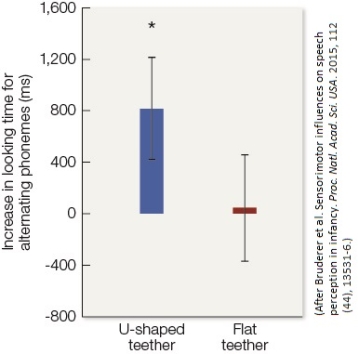Refer to the figure.
 Figure. Average looking time was measured while broadcast phonemes either alternated (between Hindi /d_/ and /dj/) or stayed the same (repeating /d_/, or repeating /dj/). Observations were taken when infants sucked on either a U-shaped teether that allowed free tongue movement (left bar) or a flat teether that immobilized subjects' tongues (right bar). Scores greater than zero indicate a preference for the alternating phonemes. Error bars denote Standard Error of the Mean. The asterisk marks a significant difference from zero.
Figure. Average looking time was measured while broadcast phonemes either alternated (between Hindi /d_/ and /dj/) or stayed the same (repeating /d_/, or repeating /dj/). Observations were taken when infants sucked on either a U-shaped teether that allowed free tongue movement (left bar) or a flat teether that immobilized subjects' tongues (right bar). Scores greater than zero indicate a preference for the alternating phonemes. Error bars denote Standard Error of the Mean. The asterisk marks a significant difference from zero.
Infants spend more time looking at a loudspeaker, on average, if they detect an acoustic change within a stream of repeating sounds that it broadcasts. Based on the figure from Bruderer et al.'s 2015 study of speech perception by 6-month-old English-speaking infants (above), does the articulatory system of infants influence whether the babies hear phoneme distinctions between non-English consonants? Explain briefly.
Correct Answer:
Verified
Q30: In general, ventriloquists seem to use techniques
Q31: Suppose you are trying to automate the
Q32: Refer to the figure. Q33: Refer to the figure. Q34: Describe examples of evidence that show how Q35: Describe the McGurk effect and how it Q36: Under what conditions does the Ganong effect Q37: You move to New York City and Q39: How does a ventriloquist exploit features of Q40: There is evidence that developmental dyslexia is
![]()
![]()
Unlock this Answer For Free Now!
View this answer and more for free by performing one of the following actions

Scan the QR code to install the App and get 2 free unlocks

Unlock quizzes for free by uploading documents